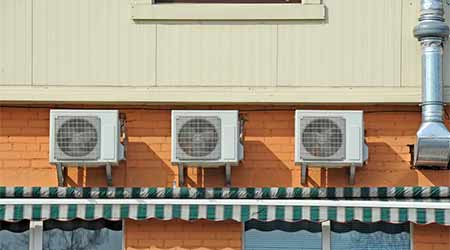Managers Must Consider Benefits of VRF System for HVAC Upgrades
Part two of a three-part article on VRF technology
Managers who are considering the use of VRF systems as part of an HVAC upgrade in their facilities need to explore the technology, determine the heating and cooling needs of the project and match the technology to the facility’s needs before making a final decision.
VRF relies on small, distributed equipment for energy savings of up to 25 percent compared to conventional systems. Part of the energy savings comes from small fans with limited ductwork, but a significant portion comes from energy sharing. Energy savings increase when systems share energy between a cooling-intensive internal zone with a heating-intensive external zone.
VRF systems offer many benefits — flexibility, energy savings, quiet equipment, varying load capacity — for many types of facilities. The room-device options provide flexibility to accommodate several space types, programs and schedules.
Commercial office buildings use VRF to maintain individual control of zones for diverse spaces, such as cubicles, enclosed offices, conference rooms, and server rooms with varying demands. The small fans and distributed devices operate quietly and are compact, allowing easier operation and installation. When buildings are remodeled, VRF systems are a match for modifications or increased and decreased loads. Low-profile outdoor units minimize the visual impact of rooftop equipment.
Managers in mixed use and multi-tenant buildings can use VRF systems for living spaces and commercial properties. Managers of buildings with multiple tenants can use the indoor units to control each room separately. Commercial buildings can use VRF systems to maintain their varying loads. Managers can use one VRF system for an entire complex and monitor electrical use for monthly billing purposes.
Historic renovation projects also offer VRF opportunities. Many historic buildings have limited capability to accommodate typical air conditioning systems that are needed for adaptive reuse. Air ducts are large, and outside air requirements demand wall louvers, but neither requirement meets typical historic renovation limitations.
VRF systems provide varying temperature control with minimal space requirements due to small indoor devices and small connecting refrigerant piping. Many jurisdictions allow minimal ventilation economizer air while using a VRF system, which reduces requirements for wall louvers.
Healthcare applications also are becoming more frequent VRF targets, despite limitations. Similar to other applications, zoning and tight temperature control are a major advantage of VRF, but filtration requirements limit use. Inpatient hospital requirements for a final filter downstream of all cooling coils limits VRF indoor device use, due to static pressure requirements that can exceed the fan capabilities.
VRF compressor technology includes linear unloading capabilities. Linear unloading provides accurate temperature control in spaces that demand tight tolerances. VRF indoor devices have been used in clean rooms, laser labs, and data centers, all areas that require temperature and repeatable temperature control.
When planning and designing a system, managers need to consider the refrigeration piping that supports the VRF system. Limitations to the design of a refrigeration system minimize the impact of a piping failure.
VRF systems include much piping throughout the entire building — although mostly small sizes — and manufacturers can assist with the design of systems by limiting the location of the balancing boxes, the size of the piping loop and the quantity of indoor devices tied to each box.
Related Topics:














